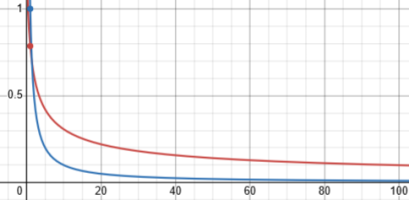I’m trying to prove that the series tangent inverse of 1/sqrtn is divergent through a limit comparison test. I started to compare it to the harmonic series, and it looks like the tangent inverse series is in fact larger than the harmonic series based on a few large values that I plugged in for n; however, I’m not sure how to prove that it is larger as n increases without bound. Any help would be much appreciated.
You are using an out of date browser. It may not display this or other websites correctly.
You should upgrade or use an alternative browser.
You should upgrade or use an alternative browser.
How to prove that a tangent inverse series is divergent.
- Thread starter knottb04
- Start date
Dr.Peterson
Elite Member
- Joined
- Nov 12, 2017
- Messages
- 16,153
For clarity: Are you talking about the series [math]\sum_{n=1}^\infty\tan^{-1}\left(\frac{1}{\sqrt{n}}\right) ?[/math]I’m trying to prove that the series tangent inverse of 1/sqrtn is divergent through a limit comparison test. I started to compare it to the harmonic series, and it looks like the tangent inverse series is in fact larger than the harmonic series based on a few large values that I plugged in for n; however, I’m not sure how to prove that it is larger as n increases without bound. Any help would be much appreciated.
And are you saying that the terms are greater than the terms of the harmonic series, [math]\tan^{-1}\left(\frac{1}{\sqrt{n}}\right)>\frac{1}{n}[/math] for [imath]n>1[/imath]?

What might it take to prove that this is always true? What ideas do you have?
Hint:I’m trying to prove that the series tangent inverse of 1/sqrtn is divergent through a limit comparison test. I started to compare it to the harmonic series, and it looks like the tangent inverse series is in fact larger than the harmonic series based on a few large values that I plugged in for n; however, I’m not sure how to prove that it is larger as n increases without bound. Any help would be much appreciated.
If [imath]\displaystyle \lim_{x\rightarrow \infty} \frac{A(x)}{B(x)} = \infty[/imath], then [imath]A(x) > B(x)[/imath]
Or
If [imath]\displaystyle \lim_{x\rightarrow \infty} \frac{B(x)}{A(x)} = 0[/imath], then [imath]A(x) > B(x)[/imath]
Dr.Peterson
Elite Member
- Joined
- Nov 12, 2017
- Messages
- 16,153
Presumably you mean, these will eventually be true for large enough x, which is what we need.Hint:
If [imath]\displaystyle \lim_{x\rightarrow \infty} \frac{A(x)}{B(x)} = \infty[/imath], then [imath]A(x) > B(x)[/imath]
Or
If [imath]\displaystyle \lim_{x\rightarrow \infty} \frac{B(x)}{A(x)} = 0[/imath], then [imath]A(x) > B(x)[/imath]
Or, one could just solve the inequality I wrote to see when it is true.
True.Presumably you mean, these will eventually be true for large enough x, which is what we need.
The whole idea that you have an inequality, [imath]A(x) > B(x)[/imath], that you are not sure it will hold true for all large numbers. You convert it to a limit, [imath]\displaystyle \lim_{x\rightarrow \infty}\frac{A(x)}{B(x)}[/imath], and try your luck that you will be able to solve it.
ButOr, one could just solve the inequality I wrote to see when it is true.
you are saying, just solve the inequality which is confusing me severely!
The inequality proposed above (response#3) needs to be solved here.the terms are greater than the terms of the harmonic series, tan−1(1n)>1n\tan^{-1}\left(\frac{1}{\sqrt{n}}\right)>\frac{1}{n}tan−1(n1)>n1 for n>1n>1n>1?
Dr.Peterson
Elite Member
- Joined
- Nov 12, 2017
- Messages
- 16,153
Give it a try. That's often the best way to understand a suggestion that doesn't yet make sense to you.True.
The whole idea that you have an inequality, [imath]A(x) > B(x)[/imath], that you are not sure it will hold true for all large numbers. You convert it to a limit, [imath]\displaystyle \lim_{x\rightarrow \infty}\frac{A(x)}{B(x)}[/imath], and try your luck that you will be able to solve it.
But
you are saying, just solve the inequality which is confusing me severely!

(Technically, solving in itself is not quite sufficient; but the work of solving can (in some cases, including this one) be reversed to obtain a proper proof.)
What you propose is an alternative method, not, as you imply, what you must do. That's my main point.
I might get what you are trying to say. Now I just remembered that there is something beautiful about [imath]\sin \theta[/imath] and [imath]\tan\theta[/imath].Give it a try. That's often the best way to understand a suggestion that doesn't yet make sense to you.
(Technically, solving in itself is not quite sufficient; but the work of solving can (in some cases, including this one) be reversed to obtain a proper proof.)
What you propose is an alternative method, not, as you imply, what you must do. That's my main point.
When the angle, [imath]\theta[/imath], is very small:
[imath]\sin\theta \approx \theta[/imath]
And
[imath]\tan\theta \approx \theta[/imath]
Therefore, when we are trying to solve the inequality in this case, we get:
[imath]\displaystyle \tan^{-1}\left(\frac{1}{\sqrt{n}}\right) > \frac{1}{n}[/imath]
[imath]\displaystyle \frac{1}{\sqrt{n}} > \tan\left(\frac{1}{n}\right) \approx \frac{1}{n}[/imath]
Which is sufficient to prove that, [imath]\displaystyle \tan^{-1}\left(\frac{1}{\sqrt{n}}\right) > \frac{1}{n}[/imath], for all large values of [imath]n[/imath].
Dr.Peterson
Elite Member
- Joined
- Nov 12, 2017
- Messages
- 16,153
There are, of course, several other steps involved to make it a proof, but I think you've seen the idea: We don't have to actually solve the inequality, but in the process of trying, we discover relationships that show that for sufficiently large n, the inequality will be true.I might get what you are trying to say. Now I just remembered that there is something beautiful about [imath]\sin \theta[/imath] and [imath]\tan\theta[/imath].
When the angle, [imath]\theta[/imath], is very small:
[imath]\sin\theta \approx \theta[/imath]
And
[imath]\tan\theta \approx \theta[/imath]
Therefore, when we are trying to solve the inequality in this case, we get:
[imath]\displaystyle \tan^{-1}\left(\frac{1}{\sqrt{n}}\right) > \frac{1}{n}[/imath]
[imath]\displaystyle \frac{1}{\sqrt{n}} > \tan\left(\frac{1}{n}\right) \approx \frac{1}{n}[/imath]
Which is sufficient to prove that, [imath]\displaystyle \tan^{-1}\left(\frac{1}{\sqrt{n}}\right) > \frac{1}{n}[/imath], for all large values of [imath]n[/imath].
This is an example of something I like to emphasize: The way to approach a proof is to explore, trying all sorts of things, which can reveal ideas you don't see while you're sitting still.
